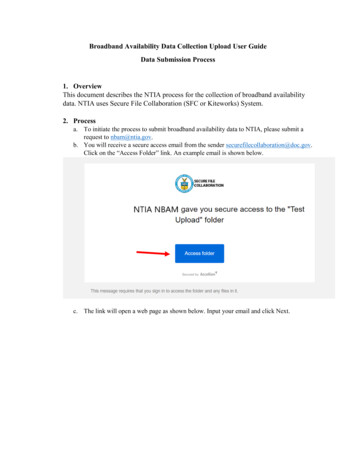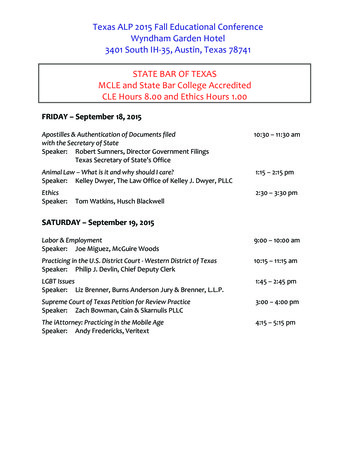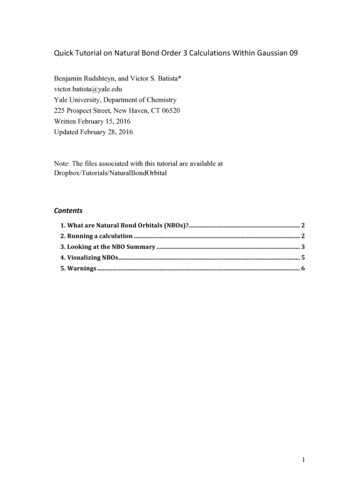
Transcription
ACCELLION, INC.FILE TRANSFER APPLIANCE (FTA) SECURITY ASSESSMENTMARCH 1, 2021
CONTENTSEXECUTIVE SUMMARY .3Summary of Results .3Project Scope .3TECHNICAL DETAILS.5Timeline of Events .5Forensic Analysis .6Validation of Accellion’s Remediation of the Exploited Vulnerabilities .8Testing FTA for Additional Vulnerabilities .92
Executive SummaryMandiant was engaged by Accellion, Inc. (Accellion) to perform a security assessment of Accellion's File TransferAppliance (FTA) software, in the wake of two related but distinct exploits used to attack client Accellion FTAsystems—one that was discovered and addressed by Accellion in December 2020 (the “December Exploit”), andanother that was discovered and addressed by Accellion in January 2021 (the “January Exploit”) (collectively, the“Exploits”).The objectives of Mandiant’s security assessment included: Independently identifying the security vulnerabilities used in the attack activity, based on review ofcompromised Accellion FTA instances Validating the patches that Accellion issued for the vulnerabilities Testing FTA version 9.12.432 (current as of the time of Mandiant testing) for further vulnerabilities in thesoftwareThis assessment was performed between February 4, 2021 and February 26, 2021.Summary of ResultsAccellion identified two zero-day vulnerabilities that were part of the December Exploit—CVE-2021-27101 andCVE-2021-27104—and two zero-day vulnerabilities that were part of the January Exploit—CVE-2021-27102 andCVE-2021-27103. Based on Mandiant’s own forensic analysis of a sample of compromised Accellion FTAinstances—which were provided to Mandiant by Accellion as well as impacted Accellion customers (ininvestigations Mandiant conducted directly for those customers), Mandiant confirmed that the attacker activityexploited these vulnerabilities (the “Exploited Vulnerabilities”). Mandiant did not identify any additionalvulnerabilities that were exploited by the attackers.1 Mandiant also validated the efficacy of the patches Accellionreleased to address the Exploited Vulnerabilities, which Accellion made available to FTA customers soon aftereach Exploit was identified.The Exploited Vulnerabilities were of critical severity because they were subject to exploitation viaunauthenticated remote code execution. Through its source code analysis and penetration testing, Mandiant didnot identify any new such unauthenticated remote code-execution vulnerabilities. Mandiant did identify twopreviously unknown authenticated-user vulnerabilities: (1) Argument Injection (CVE-2021-27730), accessible toauthenticated users with administrative privileges; and (2) Stored Cross-Site Scripting (CVE-2021-27731),accessible to regular authenticated users. The Argument Injection finding yielded a Common Vulnerability ScoringSystem (CVSS v3.0) score of 6.6 (medium severity) and the Stored Cross-Site Scripting finding was rated 8.1(high severity). Accellion has developed a patch for these two vulnerabilities (FTA 9.12.444), which Mandiant hasvalidated.Project ScopeAccellion FTA Vulnerability Identification: Mandiant reviewed the source code for Accellion FTA versions 9.12.370through 9.12.432, as well as a sample of ten (10) forensic images from affected Accellion FTA instances, in orderto identify the vulnerabilities involved in the attack activity and to test for additional vulnerabilities. This reviewinvolved the following methods:1As explained in a separate blog post, Mandiant has attributed the attack activity on FTA systems to twouncategorized threat groups—one that is believed to be responsible for compromising the systems (UNC2546),and another that is believed to be responsible for engaging in extortion activity with respect to a subset of thecompromised customers (UNC2582).3
1. Source code analysis2. Dynamic penetration testing of Accellion FTA3. Forensic analysis of compromised Accellion FTA appliancesAccellion FTA Patch Validation: Mandiant reviewed the Accellion FTA product version 9.12.432 (current as of thetime of Mandiant’s review) to validate that the version mitigated the Exploited Vulnerabilities. Mandiant thenattempted variations of exploits to determine if the 9.12.432 version of Accellion FTA could be exploited usingvariations of the known attack vectors. The following areas were reviewed during this portion of the assessment:1. Attempting alternative variations of the previously identified exploits2. Attempting to exploit web pages and web services application programming interfaces (SOAP APIs)not used by attackers4
Technical DetailsThis section describes the scope and technical details for this assessment.Timeline of EventsMandiant ReviewJanuary ExploitDecember ExploitBelow is a timeline of the relevant events, starting with the first detection of anomalous activity, up to the latestAccellion FTA patch pushed to customers.Exploit Dec. 16, 2020:First known use of December Exploit: exploit trips FTA’sbuilt-in anomaly detector on customer’s deviceInvestigation Dec. 16, 2020:Customer notifies Accellion that its anomaly detector wastriggeredInvestigation Dec. 16-19, 2020:Accellion investigates and identifies vulnerabilities affectingFTA 9.12.370 – SQL Injection (CVE-2021-27101) and OSCommand Execution (CVE-2021-27104)Mitigation Dec. 20, 2020:Accellion releases patch FTA 9.12.380, which remediatesCVE-2021-27101 and CVE-2021-27104Mitigation Dec. 23, 2020:Accellion releases patch FTA 9.12.411, increasinganomaly detector checks from one per day to one per hourExploit Jan. 20, 2021:First known use of January Exploit (unknown to Accellionat the time)Exploit Jan. 22, 2021:Through multiple customer service inquiries, Accellionlearns of anomalous activity indicative of new exploitMitigation Jan. 22, 2021:Accellion issues critical security alert advising FTAcustomers to shut down their FTA systems immediatelyMitigation Jan. 22-25, 2021:Accellion investigates and identifies Server-Side RequestForgery (CVE-2021-27103) and OS Command Execution(CVE-2021-27102) vulnerabilitiesMitigation Jan. 25, 2021:Accellion releases patch FTA 9.12.416, which remediatesCVE-2021-27102 and CVE-2021-27103Mitigation Jan. 28, 2021:Accellion releases patch FTA 9.12.432, increasingfrequency of anomaly detector checks to every 10 minutesReview Feb. 4, 2021:Mandiant begins security assessmentReview Feb. 28, 2021:Mandiant concludes assessment, identifying two newfindings – Argument Injection (CVE-2021-27730) andStored XSS (CVE-2021-27731)Mitigation Mar. 1, 2021:Accellion releases patch FTA 9.12.444, addressing CVE2021-27730 and CVE-2021-277315
Forensic AnalysisMaterials ReviewedIn analyzing the Exploited Vulnerabilities previously identified by Accellion – SQL Injection (CVE-2021-27101),Server-Side Request Forgery (SSRF) (CVE-2021-27103), and OS Command Execution (CVE-2021-27102, CVE2021-27104) – Mandiant had access to and reviewed forensic images from ten (10) affected Accellion FTAinstances. The majority of the instances reflected activity associated with the December Exploit, while the othersreflected activity associated with the January Exploit. Based on Mandiant’s experience, the activity observed onthese instances is likely to be representative of attacker activity on other affected instances not reviewed byMandiant, given the repetitive, script-like execution of the activity observed. In some cases, in addition to the FTAinstances themselves, Mandiant had access to firewall logs from the networks the FTA appliances were hostedon, which allowed Mandiant to identify additional evidence of attacker activity based on known attacker IPaddresses.How the Attack OperatedDecember ExploitWith respect to the December Exploit, Mandiant observed that the attacker chained together the followingvulnerabilities: SQL Injection (CVE-2021-27101) and OS Command Execution (CVE-2021-27104). The attackerleveraged the SQL Injection vulnerability against the file document root.html to retrieve “W” keys from theAccellion FTA database. These keys were then used to generate valid tokens that allowed the attacker to thenmake additional requests to a file named sftp account edit.php. While abusing the OS Command Executionvulnerability in this file, the attackers were able to execute their own commands, resulting in the creation of a webshell2 written to /home/seos/courier/oauth.api.The attacker likely used the newly created oauth.api web shell to upload a custom, more full-fledged web shellwith the filename of about.html (variant 1) to disk, which included highly customized tooling designed to facilitateexfiltration of data from the FTA system. While the timing of the requests resulting in the generation of this secondweb shell suggests that it was delivered via the oauth.api web shell, the available evidence does not indicatethe exact mechanism used to write it to disk. For threat-tracking purposes, Mandiant has labeled this second webshell as “DEWMODE”.The DEWMODE web shell extracts a list of available files from a MySQL database on the targeted Accellion FTAsystem and lists those files and corresponding metadata (file ID, path, filename, uploader, and recipient) on anHTML page. File download requests are captured in the web logs for the Accellion FTA system, which will containrequests to the DEWMODE web shell with encrypted and encoded URL parameters, where dwn is the file pathand fn is the requested file name. The DEWMODE webshell has features that allow the attacker to delete theAccellion FTA web logs. Forensic analysts may need to recover these logs from slack space for analysis.The uploading of the DEWMODE web shell to the file location where the attacker placed it had the effect (likelyunanticipated by and unknown to the attacker) of tripping the built-in anomaly detector included in the FTAsoftware. Once the anomaly detector is tripped, it generates an email alert to the customer (specifically to theadmin email account designated by the customer), advising the customer to contact Accellion for support. As aresult, any FTA customer affected by the December Exploit likely was sent such an email – which, per Accellion,is how the December Exploit came to its attention (see above Timeline).2A web shell is a script that can be uploaded to a web server to enable remote execution of commands.6
January ExploitMandiant observed that, after the December 20, 2020 release of patch 9.12.380, which remediated thevulnerabilities associated with the December Exploit, the attacker pivoted to a new technique involving ServerSide Request Forgery (SSRF) (CVE-2021-27103) and OS Command Execution (CVE-2021-27102).The attacker chained together an SSRF vulnerability (CVE-2021-27103) with a Command Execution vulnerability(CVE-2021-27102) to execute commands on the system. Specifically, the attacker leveraged the SSRFvulnerability against the file wmProgressstat.html to reach a local SOAP web service located in the filesw update.php, which would not otherwise be accessible from the Internet. Once access was established withthe file sw update.php, the attacker abused the OS Command Execution vulnerability in this file to create othermalicious files, including another about.html (variant 2) DEWMODE web shell used to further the remainder oftheir attack.Notably, in the case of this second exploit, the attacker uploaded the DEWMODE web shell to a different location(/home/httpd/html/about.html), likely to avoid FTA’s built-in anomaly detector. The earliest evidence wehave seen of this change in tactic appears on January 20, 2020.Both ExploitsBoth the December Exploit and the January Exploit demonstrate a high level of sophistication and deep familiaritywith the inner workings of the Accellion FTA software, likely obtained through extensive reverse engineering ofthe software. Among the things the attacker had to know were: How to call internal APIs to obtain keys to decrypt filenamesHow to forge tokens for internal API callsHow to chain together the vulnerabilities involved to conduct unauthenticated remote code executionHow to navigate FTA’s internal database, requiring a detailed understanding of the database structureHow to bypass FTA’s built-in anomaly detector (in the case of the January Exploit)Indicators of CompromiseBased on Mandiant’s review of the logs and images available for analysis, the attacker activity generated thefollowing signatures for each affected customer, all of which should be considered as signs of potentialcompromise:December ExploitThe December Exploit, which leveraged SQL Injection (CVE-2021-27101) and OS Command Execution (CVE2021-27104), yielded Indicators of Compromise (IOCs) of the following files with their respective directories: /home/seos/courier/about.html .scr/home/seos/courier/cache.jz.gzAs noted above, the attacker activity tripped FTA’s anomaly detector, causing an alert to be sent to theadministrator of the affected customer’s application.During the cleanup routine, the attacker passed a specific query parameter named csrftoken with thevalue 11454bd782bb41db213d415e10a0fb3c to DEWMODE. This would cause the following actions: A shell script is written to /tmp/.scr, which will:7
Remove all references to about.html from log files located in /var/opt/apache/ Write the modified log file to /tmp/x then attempt to replace the original log fileat /var/opt/apache/ Delete the contents of the /home/seos/log/adminpl.log log file Remove /home/seos/courier/about.html (DEWMODE)and /home/seos/courier/oauth.api (eval web shell), and redirect command output to thefile /tmp/.out Change the permissions of the output file to be readable, writeable and executable by all users,and set the owner to “nobody” Delete the script file /tmp/.scr and other temporarily created files to assist in cleanup Display cleanup output to the requesting userJanuary ExploitThe January Exploit, which leveraged Server-Side Request Forgery (SSRF) (CVE-2021-27102) and OSCommand Execution (CVE-2021-27103), yielded IOCs of the following files with their respective directories: /home/httpd/html/about.html ome/httpd/html/cache.jz.gzThe variant instance of DEWMODE used in the January Exploit (bdfd11b1b092b7c61ce5f02ffc5ad55a) had aslightly modified cleanup routine, which included wiping of /var/log/secure andremoving about.html and oauth.api from the directories /home/httpd/html/ insteadof /home/seos/courier/.During the cleanup routine, the attacker removed all references of the about.html webshell from systems’/var/opt/apache log files, cleared the /home/seos/log/adminpl.log file, removed files from the/home/httpd/html directory, and cleared the /var/log/secure log file. This variant of about.html and theanti-forensic script appear to be an improvement of the earlier variant of about.html, which failed to clear the/var/log/secure log file where previous versions of the anti-forensic script were recorded. Mandiant did identifyevidence of the anti-forensic script execution within rolled versions of the /var/log/secure log file.Validation of Accellion’s Remediation of the Exploited VulnerabilitiesAs reflected in the Timeline section, Accellion issued a patch addressing the vulnerabilities associated with theDecember Exploit on December 20, 2020 (four days after it started investigating anomalous activity associatedwith the exploit), and a patch addressing the vulnerabilities associated with the January Exploit on January 25,2021 (three days after it started investigating anomalous activity associated with the exploit, having advised allFTA customers to shut down their FTA instances in the interim).Accellion asked Mandiant to confirm that the patches successfully closed these Exploited Vulnerabilities, and thatno other vulnerabilities were exploited as part of the attack activity. Mandiant’s analysis confirmed both points.Mandiant performed patch validation of Accellion FTA 9.12.432 (which includes the December 20 and January 22patches) to validate that the latest version of Accellion FTA mitigates each of the four Exploited Vulnerabilities. As8
part of this review, Mandiant reviewed the source code in both versions 9.12.370 (pre-dating both the December20 and January 22 patches) and 9.12.432 to confirm that the changes completely mitigated the ExploitedVulnerabilities.Mandiant also tested variations of the exploit techniques involved in the Exploits to ensure that Accellion’simplementation of input validation and sanitization could not be bypassed. This component of the assessmentincluded attempting alternative variations of the Exploits, as well as attempting to exploit web pages and SOAPAPIs not initially used by attackers.Based on these analyses, Mandiant confirmed that the patches issued by Accellion fully resolved the ExploitedVulnerabilities, as shown in the table below.Identified ExploitsCVEAffected ScopeStatusSQL InjectionCVE-2021-27101document root.htmlRemediatedCommand InjectionCVE-2021-27104Multiple administrative APIendpoints3RemediatedServer-Side ediatedCommand InjectionCVE-2021-27102sw update.phpRemediatedMandiant also confirmed through forensic analysis of compromised Accellion FTA instances that the onlyvulnerabilities exploited in the attacker activity on the devices were the Exploited Vulnerabilities. Mandiant did notidentify additional vulnerabilities that were part of the attacker activity.Testing FTA for Additional VulnerabilitiesObjectives and MethodologyAccellion also asked Mandiant to review the Accellion FTA software for any other vulnerabilities Mandiant wasable to find, beyond the Exploited Vulnerabilities. Specifically, Mandiant reviewed the versions of the softwaredating from December 16, 2020 to the time of Mandiant’s review, including: �s review relied on both source code analysis and dynamic penetration testing: 3Source code analysis: Mandiant was provided a copy of unobfuscated source code by Accellion.Mandiant was also provided a list of unauthenticated endpoints provided by Accellion to prioritize.Mandiant reviewed the source code using manual techniques and did not rely on automated source codereview tools.An API endpoint can be a URL of a webpage or web service.9
Dynamic penetration testing: The focus of the dynamic penetration testing phase of the assessment wasto identify vulnerabilities by directly interacting with the Accellion FTA software. To facilitate this testing,Mandiant primarily used Burp Suite Professional (“Burp Suite”), a multifunction web proxy. Mandiantbegan the assessment by prioritizing analysis of endpoints that did not require authentication.Mandiant began to review the files corresponding to endpoints, looking for insecure usage of functions that acceptinput from an untrusted source. This methodology is referred to as “taint analysis,” as it involves identifyingpotentially insecure functions where an untrusted user input is being supplied. Mandiant analyzed each resultfrom such inputs to determine if any vulnerabilities were surfaced. As a result of this analysis, Mandiant identifieda Stored XSS vulnerability (CVE-2021-27731) resulting from lack of input validation or sanitization.Mandiant continued this analysis by manually searching for sensitive or insecure PHP built-in functions thataccepted untrusted input. Mandiant searched for insecure functions by referencing various documentation on theInternet detailing functions which have been historically exploited. In addition, Mandiant searched for additionalinstances of the functions exploited as part of the Exploited Vulnerabilities, to ensure untrusted inputs were notbeing provided to these functions. As a result of Mandiant’s analysis of application endpoints accessible only toan administrator, Mandiant observed application endpoints calling a local Perl script named admin.pl.Specifically, Mandiant searched for usage of the insecure PHP functions escapeshellargs andescapeshellcmd used in conjunction with this function. After triaging the output, Mandiant identified a single APIendpoint that did not properly sanitize user input, allowing Mandiant to inject an argument when calling theadmin.pl script (CVE2021-27730).Mandiant then proceeded to review the source code of each file corresponding to application API endpoints. Thiswas necessary as the majority of these application endpoints were not accessible from the application userinterface. In instances where functionality potentially of use to an attacker was identified, Mandiant attempted tocraft requests and manipulate inputs to probe for vulnerabilities and observe the application’s behavior.Specifically, Mandiant searched for functionality potentially susceptible to injection-based issues allowing forremote code execution or unauthorized access to data stored within the SQL database or on the remote filesystem. Mandiant did not identify any vulnerabilities as a result of this analysis.Mandiant also carefully evaluated the Accellion FTA software’s authentication logic to ensure it was notvulnerable to an authentication bypass issue, which might allow an attacker to access an authenticated endpointwithout being validly authenticated. In addition to searching for injection-based issues, Mandiant searched forissues which could allow for users to bypass authentication or authorization controls. For example, Mandiantattempted to tamper with inputs containing session information such as cookies or tokens, to see if the requestedapplication endpoint or file could still be accessed. Mandiant did not identify any vulnerability through thisanalysis.Results of Testing FTA for Additional VulnerabilitiesThe Exploited Vulnerabilities were of critical severity because they allowed for remote code execution by anunauthenticated user. Mandiant’s source code analysis and penetration testing did not identify any newunauthenticated remote code-execution vulnerabilities beyond the Exploited Vulnerabilities.Mandiant identified two new findings for authenticated users, consisting of Argument Injection (CVE-2021-27730),which was accessible only to authenticated users with administrative privileges, and a Stored Cross-Site Scripting(CVE-2021-27731), which was accessible only to regular authenticated users. The Argument Injection findingyielded a CVSS v3.0 score of 6.6 (medium severity) and the Stored Cross-Site Scripting finding was rated 8.1(high severity).After being alerted to Mandiant’s findings, Accellion developed FTA patch 9.12.444 to address these newlyidentified findings. Mandiant validated that the patch effectively remediated these vulnerabilities, specificallyattempting to exploit FTA version 9.12.444 and confirming that injected input was correctly sanitized.10
Disclaimer: While every precaution has been taken in the preparation of this document, neither Accellion norMandiant assumes any responsibility for errors or omissions resulting from the use of the information herein.FireEye, Inc.About FireEye, Inc.601 McCarthy Blvd. Milpitas, CA 95035408.321.6300/877.FIREEYE (347.3393)info@FireEye.comFireEye is the intelligence-led security company. Working as aseamless, scalable extension of customer security operations,FireEye offers a single platform that blends innovative securitytechnologies, nation-state grade threat intelligence, andworld-renowned Mandiant consulting. With this approach,FireEye eliminates the complexity and burden of cyber securityfor organizations struggling to prepare for, prevent, andrespond to cyber attacks. FireEye has over 5,300 customersacross 67 countries, including more than 845 of the ForbesGlobal 2000. 2021 FireEye, Inc. All rights reserved. FireEye is aregistered trademark of FireEye, Inc. All otherbrands, products, or service names are or may betrademarks or service marks of their respectiveowners.
7hfkqlfdo 'hwdlov 7klv vhfwlrq ghvfulehv wkh vfrsh dqg whfkqlfdo ghwdlov iru wklv dvvhvvphqw 7lpholqh ri (yhqwv %horz lv d wlpholqh ri wkh uhohydqw hyhqwv vwduwlqj zlwk wkh iluvw ghwhfwlrq ri dqrpdorxv dfwlylw\ xs wr wkh odwhvw










